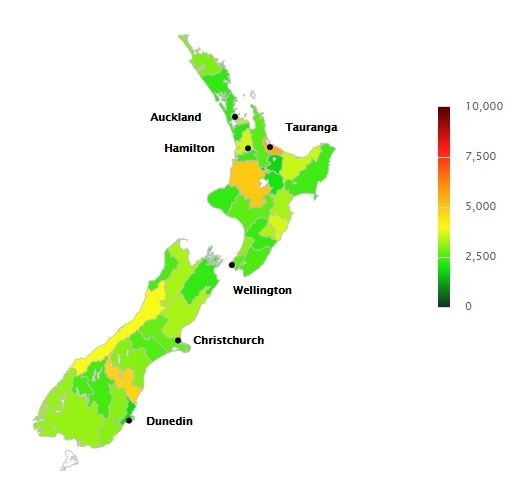
Today's Top 10 is a guest post from Nirmal-Kumar Nair, an associate professor at the Department of Electrical and Computer Engineering at the University of Auckland.
As always, we welcome your additions in the comments below or via email to david.chaston@interest.co.nz.
And if you're interested in contributing the occasional Top 10 yourself, contact gareth.vaughan@interest.co.nz.
See all previous Top 10s here.
For this Top 10, I highlight renewable energy, electric transport and smart cities move towards future trends and solicit your comments and opinions.
1. NZ Electricity stock-take Oct 2015 (Tiwai, Huntly, grid upgrade).
In my May 2014 Top-10, I shared on energy policy and renewable uptake globally. For the 2015 NZ stock-take I still feel we are in a similar position, as commented then, where the big question is all about “Show me the future electrical Load”. We are ticking along pretty nicely for renewables, which clocked 82.8% in the recent quarter.
With a potential reduction or closure of Tiwai smelter load in the future, factoring no other significant industry eventuating in South Island, will release extra capacity. This will then have to be transported, through a 2013 estimated grid upgrade investment option of $110 million, to the load centres wherever required. The inter-island grid upgrade has further future-proofed our capability for increased power transfer between north and south islands. The closure of the two thermal units at Huntly by 2018 further reaffirms our path towards higher renewable electricity capacity addition for the future.
2. Building more large-scale renewable generation in the Far North.
Despite a low load growth scenario and increased renewable generation on the horizon, it is exciting to see geothermal expansion plans in the Far North. This provides more economic development and energy security for our northern-most region. On the other hand the potential slowing down of Tiwai adds economic uncertainty to our far south, which will have to reinvent itself to accommodate activities that can leverage its local bulk generation.
3. Herfindahl-Hirschman Index (HHI) and the GINI coefficient in energy.
The Herfindahl-Hirschman Index used by economists for analysing market concentration, and the GINI coefficient used statistically for inequality appears eclectically in electricity (energy) discussions providing intellectual horse-power around electricity deregulated markets and energy poverty respectively. As an engineer who trained in the electricity market during my doctoral research, I still reflect on the applicability of these measures for dictating public policy and media discussions. Usually these are observed to be used by opposing entities to justify and support their viewpoint. These measures are able to just factor the current state of our affairs and structures but do not capture the impact of technological and organisation changes that energy industry experiences, or does it?
(GINI Stats) picture

4. International blackout watch.
Continuing on from my Feb 2015 Top 10 item #9 on blackouts, and May 2015 item #9 on Turkey’s complete country wide shut down, this item is on the UK who are on an alert for potential blackouts due to increased stress on their supply situation. Apart from the traditional focus around building capacity, they are embarking upon igniting innovation in a capital and regulation intense industry like energy through their establishment of national CATAPULT centres, one of them being in energy.
5. Top 10 renewable energy cities in the world: Can Auckland make the list?
I had several items about cities in my May 2015 Top 10. Here I revisit that in the context of Auckland’s energy plans by 2040. One of my first interactions with interest.co.nz was a Double-Shot interview based on work we did at the University of Auckland estimating the solar potential for Auckland. Elon Musk’s EV patent release and home storage batteries news has emerged since then. Maybe Auckland has the chance after all to make the Top 10 renewable energy cities by 2040.
6. Energy ‘chattels’ for future home sales?
Speaking about Auckland, I cannot resist including an item about Auckland homes. Do property investors or home buyers factor the valuation of chattels for investment property purchase and tax purposes? Any ideas of how to factor energy technologies like solar PV and home storage batteries into this space?
7. Charging ‘rage’ rising for EV drivers.
Speaking about future electricity loads, the following item caught my attention regarding literally “charging” rage rather than the previously prevalent range anxiety capturing Californian EV drivers. As transportation moves towards a low-carbon energy future, practical issues like the above are sure to crop-up and capture our attention.
8. Self-driving cars and insurance?
The investment community came to hear about self-driving cars following the 2014 Berkshire Hathaway annual meeting. This was primarily due to the potential impact on its insurance business GEICKO. If readers would like to know about the latest technical focus and developments regarding this technology area, check out this here and Toyota’s announcement here.
9. How about another regional airport in Auckland?
Greater London caters to about 8.65 million people and is serviced by about six airports. With Auckland's population expected to be 1.646 million by 2018, is it time for another airport?
I ask this because of the regular discussions I have been having with my colleagues who live on the North Shore. They say attending meetings outside Auckland requires a whole day off if they're flying out and back into the city. Similarly having a meeting here in Auckland (particularly at a North Shore location) also is not preferred by non-Auckland attendees flying inwards, if there is no overnight stay involved.
10. The future of universities.
I've look at university education in my previous Top 10 columns, item #4 in February on the cost of tuition fees; and item # 8 in May on Australia/New Zealand international students. I follow this up with a Financial Times piece on the future of universities. Whatever the future projections may be, tertiary education amongst younger adults is on the rise in all OECD countries as shown below.
Chart 1.4 Percentage of younger adults with tertiary education (2000 and 2013) 25-34 year-olds (Source: OECD, Education at a Glance).
And there's more here.
2 Comments
#10, The numbers are up, but the advances not so much. There remains the yawning and clearly identifiable gulf between intelligence and education. The incumbents will not relinquish the current model but it is bound to continue churning out the same old mix of educated, but largely under-achieving bulk while capturing precious few at the top end, leaving many very smart people fallow or misdirected into sub-optimal pursuits.
So long as institutions require upfront payment and accept no responsibility for outcomes we will have dumb rich people telling smart poor people that they are not qualified to play in the club and course content which is not particularly stretching to allow them to say that.
Rather than pay for bums on seats, Government could put out to tender for the supply of successful high quality graduates in a certain discipline. They would be required to pass an assessment which was independent of the institution. No payment for turning out failures.
Privilege will always buy you a degree and the scholarships are mostly about special interests over academic excellence. This can not be held as the pinnacle when greater minds are overlooked or denied.
Re #2, great to see the Ngawha expansion getting the go ahead and not just for the electricity production.
The plan, as I understand it, is to use the spare heat for industrial use - milk powder or timber processing for example. They are talking 200+ jobs right on the outskirts of Kaikohe.
We in the Far North are sick of seeing our considerable primary production trucked off elsewhere for processing - wrecked roads and bugger all work and income for our local people. Congratulations to Top Energy.
We welcome your comments below. If you are not already registered, please register to comment
Remember we welcome robust, respectful and insightful debate. We don't welcome abusive or defamatory comments and will de-register those repeatedly making such comments. Our current comment policy is here.